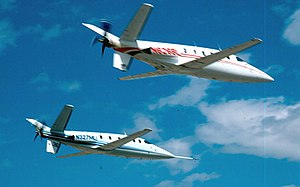
The Convair R3Y Tradewind was an American 1950s turboprop-powered flying boat designed and built by Convair.
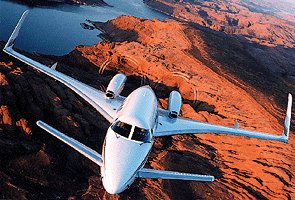
The Beechcraft Starship is a twin-turboprop six- to eight-passenger pressurized business aircraft produced by Beech Aircraft Corporation. Notable for its unusual canard design and extensive use of carbon fiber composite, it did not sell many units and production ceased in 1995, only six years after the Starship's first flight.
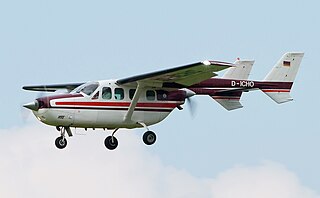
The Cessna Skymaster is an American twin-engine civil utility aircraft built in a push-pull configuration. Its engines are mounted in the nose and rear of its pod-style fuselage. Twin booms extend aft of the wings to the vertical stabilizers, with the rear engine between them. The horizontal stabilizer is aft of the pusher propeller, mounted between and connecting the two booms. The combined tractor and pusher engines produce centerline thrust and a unique sound. The Cessna O-2 Skymaster is a military version of the Cessna 337 Super Skymaster.

The Douglas A2D Skyshark was an American turboprop-powered attack aircraft built by the Douglas Aircraft Company for the United States Navy. The program was substantially delayed by engine reliability problems, and was canceled because more promising jet attack aircraft had entered development and the smaller escort carriers the A2D was intended to utilize were being phased out.

The Consolidated Vultee XP-81 is a development of the Consolidated Vultee Aircraft Corporation to build a single seat, long range escort fighter that combined use of both turbojet and turboprop engines. Although promising, the lack of suitable engines combined with the end of World War II doomed the project.

The Antonov An-14 Pchelka or Pchyolka, Bdzhilka is a Soviet utility aircraft which was first flown on 15 March 1958. It was a twin-engined light STOL utility transport, with two 300 hp Ivchenko AI-14RF radial piston engines. Serial production started in 1966, and about 300 examples were built by the time production ended in 1972. The An-14 failed to replace the more successful An-2 biplane, which was manufactured until 1990,. The An-14's successor, the An-28 with turboprop engines, is still manufactured at PZL Mielec factories in Poland, under the names PZL M28 Skytruck and PZL M28B Bryza.

The Cessna 441 Conquest II is the first turboprop powered aircraft designed by Cessna and was meant to fill the gap between their jets and piston-engined aircraft. It was developed in November 1974, with the first aircraft delivered in September 1977. It is a pressurized, 8–9 passenger turbine development of the Cessna 404 Titan.

The Beriev Be-6 was a flying boat produced by the Soviet Beriev OKB. It was capable of accomplishing a wide variety of missions, such as long-range maritime reconnaissance, coastal and supply line patrols, torpedo/bombing strikes, mine-laying, and transport operations.

The Cessna 425, known as the Corsair and later as the Conquest I, is an eight-seat American pressurized turboprop twin-engined light aircraft. Now out of production, it was built by Cessna Aircraft of Wichita, Kansas, between 1980 and 1986.

The Cessna 421 Golden Eagle is an American six or seven seat twin-engined light transport aircraft, developed in the 1960s by Cessna as a pressurized version of the earlier Cessna 411.

The Piper PA-42 Cheyenne is a turboprop aircraft built by Piper Aircraft. The PA-42 Cheyenne is a larger development of the earlier PA-31T Cheyennes I and II.

The Scaled Composites Triumph is a twin-engine, business jet prototype designed and built by Burt Rutan's Scaled Composites for Beechcraft. It was known officially as the Model 143, and internally at Scaled as the "Tuna". The aircraft is a three lifting surface design, with both a small canard, and a small conventional horizontal stabilizer in a T-tail configuration.
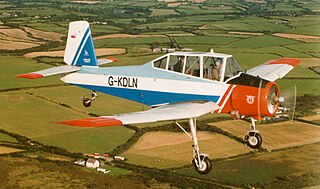
The Zlin Z-37 Čmelák, also known as LET Z-37 Čmelák is an agricultural aircraft which was manufactured in Czechoslovakia. It is powered by a Soviet-built Ivchenko reciprocating engine. The aircraft is used mainly as a cropduster.
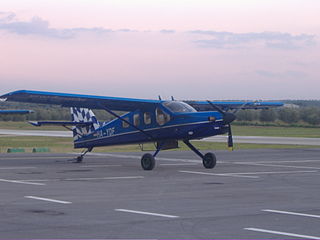
The Technoavia SM92 Finist is a utility aircraft with a STOL capability, designed by the Russian company Technoavia. The maiden flight was on 28 December 1993. It is built by the Smolensk Aviation Plant.

The Lamco Eurocub is a Hungarian ultralight aircraft with fixed conventional landing gear, manufactured by Danex Engineering Kft. It is used primarily for flight training, touring and personal flying.

The Mississippi State University XV-11A Marvel was an experimental American STOL research aircraft of the 1960s. The MARVEL (Mississippi Aerophysics Research Vehicle with Extended Latitude) was a single-engined pusher monoplane fitted with a boundary layer control system. The first all-composite aircraft, it carried out its initial program of research on behalf of the US Army in the late 1960s, and was rebuilt in the 1980s as a proof-of-concept for a utility aircraft.
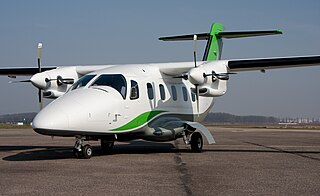
The Evektor EV-55 Outback is a twin-engine turboprop aircraft designed and built in the Czech Republic by Evektor-Aerotechnik. The prototype first flew on 24 June 2011. The project's development was suspended in March 2017.

The Commuter Aircraft Corporation CAC-100 was a 50–60 seat, four-engined, turboprop commuter airliner developed in the United States in the late 1970s and early 1980s.

The Otto Celera 500L is a business and utility light aircraft developed by American startup, Otto Aviation. By November 2021, 55 successful test flights had been completed, as introduction is targeted for 2023–2025. It has a single RED A03 diesel piston engine in a pusher configuration and can seat six passengers. It is named after the latin word for 'fast,' celer.
The Vought V-326 was an American experimental aircraft used by Pratt & Whitney as a high altitude engine test bed.
